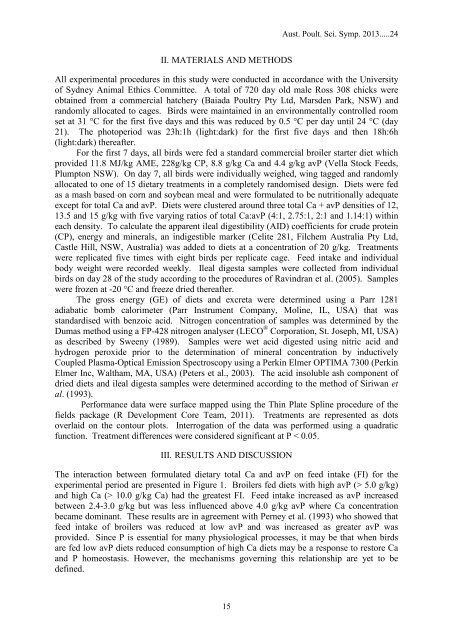APSS 2013 Proceedings - The University of Sydney
APSS 2013 Proceedings - The University of Sydney
APSS 2013 Proceedings - The University of Sydney
You also want an ePaper? Increase the reach of your titles
YUMPU automatically turns print PDFs into web optimized ePapers that Google loves.
Aust. Poult. Sci. Symp. <strong>2013</strong>.....24<br />
II. MATERIALS AND METHODS<br />
All experimental procedures in this study were conducted in accordance with the <strong>University</strong><br />
<strong>of</strong> <strong>Sydney</strong> Animal Ethics Committee. A total <strong>of</strong> 720 day old male Ross 308 chicks were<br />
obtained from a commercial hatchery (Baiada Poultry Pty Ltd, Marsden Park, NSW) and<br />
randomly allocated to cages. Birds were maintained in an environmentally controlled room<br />
set at 31 °C for the first five days and this was reduced by 0.5 °C per day until 24 °C (day<br />
21). <strong>The</strong> photoperiod was 23h:1h (light:dark) for the first five days and then 18h:6h<br />
(light:dark) thereafter.<br />
For the first 7 days, all birds were fed a standard commercial broiler starter diet which<br />
provided 11.8 MJ/kg AME, 228g/kg CP, 8.8 g/kg Ca and 4.4 g/kg avP (Vella Stock Feeds,<br />
Plumpton NSW). On day 7, all birds were individually weighed, wing tagged and randomly<br />
allocated to one <strong>of</strong> 15 dietary treatments in a completely randomised design. Diets were fed<br />
as a mash based on corn and soybean meal and were formulated to be nutritionally adequate<br />
except for total Ca and avP. Diets were clustered around three total Ca + avP densities <strong>of</strong> 12,<br />
13.5 and 15 g/kg with five varying ratios <strong>of</strong> total Ca:avP (4:1, 2.75:1, 2:1 and 1.14:1) within<br />
each density. To calculate the apparent ileal digestibility (AID) coefficients for crude protein<br />
(CP), energy and minerals, an indigestible marker (Celite 281, Filchem Australia Pty Ltd,<br />
Castle Hill, NSW, Australia) was added to diets at a concentration <strong>of</strong> 20 g/kg. Treatments<br />
were replicated five times with eight birds per replicate cage. Feed intake and individual<br />
body weight were recorded weekly. Ileal digesta samples were collected from individual<br />
birds on day 28 <strong>of</strong> the study according to the procedures <strong>of</strong> Ravindran et al. (2005). Samples<br />
were frozen at -20 °C and freeze dried thereafter.<br />
<strong>The</strong> gross energy (GE) <strong>of</strong> diets and excreta were determined using a Parr 1281<br />
adiabatic bomb calorimeter (Parr Instrument Company, Moline, IL, USA) that was<br />
standardised with benzoic acid. Nitrogen concentration <strong>of</strong> samples was determined by the<br />
Dumas method using a FP-428 nitrogen analyser (LECO ® Corporation, St. Joseph, MI, USA)<br />
as described by Sweeny (1989). Samples were wet acid digested using nitric acid and<br />
hydrogen peroxide prior to the determination <strong>of</strong> mineral concentration by inductively<br />
Coupled Plasma-Optical Emission Spectroscopy using a Perkin Elmer OPTIMA 7300 (Perkin<br />
Elmer Inc, Waltham, MA, USA) (Peters et al., 2003). <strong>The</strong> acid insoluble ash component <strong>of</strong><br />
dried diets and ileal digesta samples were determined according to the method <strong>of</strong> Siriwan et<br />
al. (1993).<br />
Performance data were surface mapped using the Thin Plate Spline procedure <strong>of</strong> the<br />
fields package (R Development Core Team, 2011). Treatments are represented as dots<br />
overlaid on the contour plots. Interrogation <strong>of</strong> the data was performed using a quadratic<br />
function. Treatment differences were considered significant at P < 0.05.<br />
III. RESULTS AND DISCUSSION<br />
<strong>The</strong> interaction between formulated dietary total Ca and avP on feed intake (FI) for the<br />
experimental period are presented in Figure 1. Broilers fed diets with high avP (> 5.0 g/kg)<br />
and high Ca (> 10.0 g/kg Ca) had the greatest FI. Feed intake increased as avP increased<br />
between 2.4-3.0 g/kg but was less influenced above 4.0 g/kg avP where Ca concentration<br />
became dominant. <strong>The</strong>se results are in agreement with Perney et al. (1993) who showed that<br />
feed intake <strong>of</strong> broilers was reduced at low avP and was increased as greater avP was<br />
provided. Since P is essential for many physiological processes, it may be that when birds<br />
are fed low avP diets reduced consumption <strong>of</strong> high Ca diets may be a response to restore Ca<br />
and P homeostasis. However, the mechanisms governing this relationship are yet to be<br />
defined.<br />
15
















